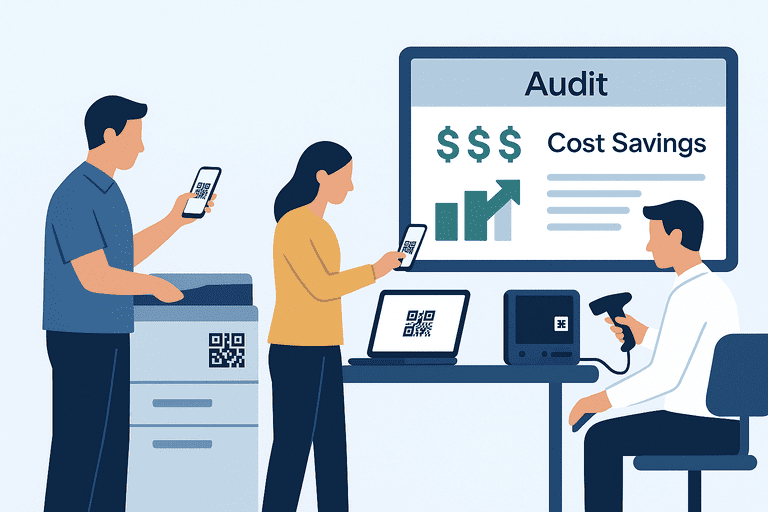How to Save Money with Preventive Asset Audits
Preventive asset audits save money by reducing losses, spotting inefficiencies, and extending asset lifespans. Learn how to do them right.

Introduction
Most businesses see audits as a compliance headache — something to get through once a year to satisfy regulators. But preventive asset audits are different.
Instead of reacting to problems after they happen, preventive audits are proactive checks that keep assets in good shape, identify inefficiencies early, and stop costs from piling up.
This article explains how preventive asset audits save money and offers a practical guide to implementing them in your business.
What Are Preventive Asset Audits?
A preventive asset audit is a scheduled review of business assets before problems occur.
Unlike a reactive audit (done after losses, thefts, or compliance issues are discovered), preventive audits:
- Verify asset location and condition.
- Check whether usage records match reality.
- Identify potential issues (overuse, misuse, damage) before they get costly.
Think of it like preventive healthcare — regular checkups keep small issues from becoming expensive problems.
Why Preventive Audits Save Money
1. Reduced Losses & Theft
When employees know audits happen regularly, accountability increases. Missing items are noticed faster, reducing losses.
Savings: Fewer replacements of laptops, tools, and shared equipment.
2. Fewer Duplicate Purchases
Audits confirm what assets you already own, avoiding unnecessary orders.
Savings: No more “just in case” duplicate buys.
3. Extended Asset Lifespan
Audits spot wear and tear early. Preventive maintenance extends the life of expensive equipment.
Savings: Delayed replacement costs for machines, electronics, and furniture.
4. Compliance & Insurance Benefits
Accurate, up-to-date records prevent fines and simplify insurance claims.
Savings: Avoiding non-compliance penalties and denied claims.
5. Smarter Budget Planning
Audit data highlights underused or obsolete assets. Businesses can sell, repurpose, or reassign them.
Savings: Lower capital expenditure and optimized resource allocation.
How to Conduct Preventive Asset Audits
Step 1: Define Audit Scope
- Decide which assets to include (IT, furniture, vehicles, tools).
- Focus on high-value or high-risk categories first.
Step 2: Tag All Assets
- Use QR codes or barcodes to assign unique IDs.
- Place labels in consistent, visible spots.
Step 3: Create a Digital Register
- Import all assets into inventory management software.
- Record purchase date, location, assigned user, and condition.
Step 4: Schedule Audits
- Quarterly mini-audits for high-value items.
- Annual full audits across all assets.
Step 5: Train Staff
- Teach employees how to scan assets during audits.
- Make accountability part of company culture.
Step 6: Review Reports
- Look for discrepancies: missing, duplicated, or underused assets.
- Take corrective actions (reallocate, repair, retire).
Example: Preventive Audits in Action
A medium-sized IT firm with 200 laptops ran only yearly audits. Each year, 10–15 devices went missing or broke without proper logs, costing $20,000 annually.
After implementing quarterly preventive audits with asset management system:
- QR codes made scanning fast.
- Missing items were identified immediately.
- Repairs were scheduled before damage worsened.
- Replacement costs dropped by 40%.
Best Practices Checklist
- Tag all assets with QR/barcodes.
- Maintain a central digital asset register.
- Schedule quarterly audits for high-value items.
- Record asset condition during every audit.
- Use reports to reallocate or retire assets.
- Train staff on scanning and accountability.
👉 For a related guide, see Reducing Shrinkage and Loss with Smart Inventory Tools.
Common Mistakes to Avoid
- Treating audits as a yearly compliance task only.
- Relying on paper logs or spreadsheets — too error-prone.
- Ignoring small items — cables, chargers, and supplies add up.
- Skipping condition checks — leads to unexpected breakdowns.
- Not acting on audit reports — data without action = wasted effort.
Conclusion
Preventive asset audits are not just about compliance — they’re a cost-saving strategy. By identifying problems early, businesses cut losses, reduce duplicate purchases, extend equipment life, and improve compliance.
With the right tools, preventive audits become faster, easier, and more effective. The result? Lower operating costs and better asset performance.
👉 Want to make preventive audits easy and cost-effective? Try InvyMate today — the QR-powered solution that saves time, reduces losses, and cuts costs.